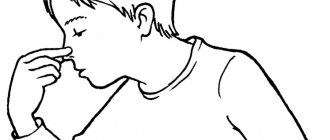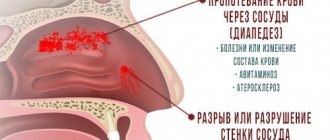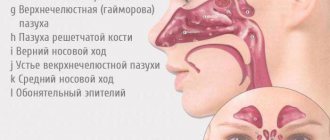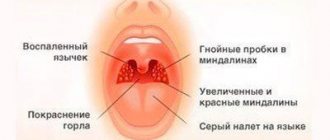Lump in the throat
Many people often experience such an unpleasant feeling as a lump in the throat. Depending on the cause, this symptom may be accompanied by other unpleasant symptoms from the body (for example, shortness of breath and difficulty breathing), and may occur periodically or constantly.
Typically, a lump in the throat refers to a condition in which a person has difficulty breathing and swallowing. At the same time, he may experience increased salivation and increased heart rate. There are many reasons for a lump in the throat. These can be both psychological experiences that are not related to the presence of diseases, as well as some pathologies that are sometimes dangerous to health and life.
Causes of a lump in the throat
Let us first consider the reasons that are not related to the presence of certain diseases of the body:
- stress;
- strong fear;
- fright;
- excitement.
Severe anxiety before an exam, an important interview, or fear of visiting the dentist can cause symptoms such as hand tremors, indigestion, difficulty breathing, and increased sweating.
A person under stress usually also complains of difficulty breathing, dryness and a lump in the throat.
Such a condition is not a deviation and goes away within a few minutes (hours) after the main cause of its occurrence has been eliminated (an exam has been passed, an interview has been completed, etc.).
There is a separate category of people who regularly experience so-called panic attacks. The causes of this condition are varied. It is not considered as a separate disease and more often becomes a manifestation of vegetative-vascular dystonia.
Symptoms of another approaching panic attack include a lump in the throat, difficulty breathing, increased heart rate, darkening of the eyes, and increasing anxiety.
This condition, as a rule, does not threaten human health, but its frequent occurrence can significantly reduce the quality of life.
A lump in the throat is a characteristic symptom of many diseases of the upper respiratory tract, occurring in acute or chronic form. These diseases include: tonsillitis, pharyngitis, bronchitis.
If you have an upper respiratory tract infection, you will necessarily experience symptoms such as pain, sore throat, cough, nasal congestion, fever, and general deterioration in health.
Allergies and adenoids can also cause an unpleasant feeling of a lump in the throat.
The rarest cause of this symptom is a rapidly progressing tumor of the nasopharynx, compressing adjacent tissues and thereby causing lack of air, difficulty swallowing, increased salivation, etc.
Also, a frequently occurring feeling of a lump in the throat can be caused by diseases of various body systems:
- hyperthyroidism, thyroid adenoma;
- hernia of the upper spine;
- esophagitis, gastritis.
When diagnosing the cause, it is important to pay attention to accompanying symptoms and manifestations.
Feeling of a lump in the throat - what is it?
In itself, the phenomenon of a lump in the throat does not pose a danger to human health. Usually it goes away safely within a few minutes after its occurrence, and then appears again (with severe stress or anxiety).
If the cause of this symptom lies in vegetative-vascular dystonia or chronic depression, it can occur at any time of the day, regardless of surrounding circumstances.
In such a case, it is recommended to contact a specialist - a neurologist or psychiatrist, who will prescribe effective treatment.
Many patients facing psychological problems benefit from visiting a psychologist. This specialist will first try to identify the cause of the pathology, in this case - prolonged depression, stress or panic attacks, and will help get rid of it in order to avoid unpleasant manifestations from the body in the future.
The feeling of a foreign object in the throat and difficulty swallowing are characteristic of various diseases of the thyroid gland. First of all, for diffuse toxic goiter (Graves disease), the occurrence of which is associated with a lack of iodine in the human body.
Usually the disease is asymptomatic; in the later stages of its development, the patient experiences cardiac dysfunction, weight loss, and frequent digestive disorders. A characteristic manifestation of Graves' disease is protrusion of the eyeballs or exophthalmos.
Without treatment, the disease progresses rapidly and the likelihood of developing a thyrotoxic crisis increases. It is not possible to determine the presence of pathology by the presence of one or two symptoms.
Diagnosis of diffuse goiter is based not only on a patient interview, but also on blood test data and ultrasound of the thyroid gland.
Some diseases are practically asymptomatic. Their presence is precisely indicated by such a minor change on the part of the body as a lump in the throat. In this case we are talking about laryngeal tumors. These tumors can be benign: polyps, granulomas, cysts, fibroids, and malignant or cancerous.
In such cases, the sensation of a foreign body or lump in the throat is associated with the tumor reaching a certain size, when it becomes noticeable and puts pressure on neighboring tissues.
At a later stage in the development of the disease, the patient also experiences other symptoms: enlargement of the submandibular and cervical lymph nodes, hoarseness, sore throat, cough, difficulty breathing, impaired swallowing function.
If you experience a frequent feeling of a lump in your throat, you should consult a specialist, even in the absence of any other symptoms, since this manifestation of the body may indicate the presence of life-threatening pathologies, the treatment of which must begin as early as possible.
How to get rid of a lump in your throat
Treatment is prescribed taking into account the cause of the symptom. There are several ways to get rid of an unpleasant feeling in the throat.
For example, if its occurrence is associated with any disease of the upper respiratory tract, it is recommended to gargle regularly throughout the day with an antiseptic solution (chamomile decoction, water with sea salt and iodine are also suitable).
Eliminating the symptoms of tonsillitis is facilitated by sucking special tablets (Strepsils) and irrigating the throat with a spray (Stopangin). These medications actively fight bacteria that cause inflammation and help eliminate pain, soreness, eliminate the feeling of a foreign body in the throat, and prevent coughing.
You can ease the unpleasant manifestations of fear, anxiety or an impending panic attack with the help of regular drinking water. In this case, you should drink the liquid in small sips. People who experience frequent panic attacks are advised to always keep a small bottle of water in their bag.
In many cases, eliminating the symptom of a lump in the throat alone is not enough; treatment of a specific disease is necessary, first of all this concerns various tumors of the throat and hyperthyroidism.
Source: https://pro-simptomy-lechenie.ru/kom-v-gorle/
https://youtu.be/https://www.youtube.com/watch?v=DX8wUmnr1sE
_
What causes symptoms such as: feeling of a lump in the throat, stuffy nose
Below are diseases that match your symptoms.
Laryngotracheitis
Laryngotracheitis is an inflammatory process with typical signs of an acute respiratory infection that affects the larynx and trachea.
The pathogenesis of the disease is caused by a bacterial or viral infection. With untimely treatment or weak immunity, inflammation gradually covers the lower respiratory tract, developing into pneumonia, bronchitis, bronchiolitis. Read more- hoarse voice
- stuffy nose
- a sore throat
- headache
- fatigue
- weakness
- elevated temperature
- runny nose
- feeling of a lump in the throat
- dry mouth
- dry cough
Anaphylactic shock
Anaphylactic shock is an acute manifestation of an allergic reaction that is life-threatening.
In 20% of cases it ends in death. Anaphylactic shock is less common in children than in adults. Read more- dyspnea
- tongue swelling
- dizziness
- vomit
- chest pain
- suffocation
- headache
- low blood pressure
- spasm
- weakness
- nausea
- cardiopalmus
- sweating
- itching
- feeling of a lump in the throat
- involuntary urination
- ear congestion
- thready pulse
Allergic Rhinitis
Allergic rhinitis or hay fever is the body's reaction to certain allergens.
This causes unpleasant symptoms such as sneezing and itchy eyes. There are two types of allergic rhinitis: seasonal hay fever or pollen allergy) and year-round (reaction to household allergens: house dust, animals, etc.). Read more- poor appetite
- sinusitis
- dyspnea
- sneeze
- stuffy nose
- taste disorder
- a sore throat
- impaired concentration
- my eyes are watering
- fatigue
- blisters
- wheezing
- cough
- decreased attention
- headache
- high-pitched wheezing
- irritation of the nasal mucosa
- nosebleed
- impaired sense of smell
- weakness
- runny nose
- loss of smell
- sore throat
- itchy nose
- hives
Enlarged adenoids
Enlarged adenoids are a common problem in young children. Adenoids enlarge in response to frequent respiratory infections. Because, on the one hand, adenoids are the body’s defense organ. On the other hand, it is a kind of “training” for the immune system.
- smell from the mouth
- wheeze
- stuffy nose
- a sore throat
- sleep problems
- deterioration of sense of smell
- xerostomia
- impaired sense of smell
- difficulty swallowing
- snore
Thyroiditis
Thyroiditis is an inflammatory disease of the thyroid gland.
There are acute, subacute, chronic autoimmune and chronic fibrotic natures of the disease. Read more- hoarse voice
- rapid pulse
- swollen lymph nodes
- tachycardia
- chills
- headache
- high blood pressure
- joint pain
- earache
- pain in the neck
- weakness
- elevated temperature
- difficulty swallowing
- sweating
- enlarged thyroid gland
- feeling of a lump in the throat
- dry cough
- muscle pain
- trembling hands
- redness of the neck skin
- jaw pain
- pain in the back of the head
- sore throat
Parainfluenza
Parainfluenza is an acute viral disease, the course of which is accompanied by damage to the upper respiratory tract (mainly the larynx) and is characterized by mild intoxication of the body.
Read more- poor appetite
- fever
- hoarse voice
- dyspnea
- stuffy nose
- a sore throat
- pale skin
- chest pain
- cough
- labored breathing
- lethargy
- apathy
- pain when swallowing
- nausea
- muscle weakness
- elevated temperature
- runny nose
- intoxication
- wheezing in the lungs
Sarcoidosis
Sarcoidosis is a non-infectious systemic inflammatory disease that can affect many organs and systems (in particular the lungs), characterized by the formation of granulomas in the affected tissues (this is one of the diagnostic signs of the disease, which is revealed by microscopic examination; limited foci of inflammation, in the form of a dense nodule of various sizes).
The lymph nodes, lungs, liver, spleen are most often affected, and less often - skin, bones, organ of vision, etc. Read more- photophobia
- polyuria
- poor appetite
- fever
- Red eyes
- feeling of heartbeat
- shortness of breath on exertion
- itchy skin
- rash
- dyspnea
- burning in the eyes
- stuffy nose
- night sweats
- swollen face
- swollen joints
- swollen lymph nodes
- sleep problems
- abdominal pain
- blindness
- blurred vision
- spots before eyes
- fatigue
- weight loss
- wheezing
- xerostomia
- anemia
- pale skin
- chest pain
- color vision disorder
- coma
- cough
- hot skin
- headache
- hearing loss
- heart fluttering
- high-pitched wheezing
- joint pain
- fatigue
- hair loss
- blurry vision
- confusion
- spasm
- myalgia
- nosebleed
- bad feeling
- lack of appetite
- numbness
- eyes hurt
- pain
- weakness
- dry mouth
- dry cough
- muscle pain
- pain in the heart area
- wheezing in the lungs
Coronavirus COVID-19
Coronavirus infection COVID-19 is an infectious disease caused by a new coronavirus that has not previously been detected in humans.
Exposure to this virus results in the development of a respiratory influenza-like illness with symptoms such as cough, fever and, in more severe cases, pneumonia. Before the outbreak in Wuhan, China, in December 2020, the new virus and disease were unknown. Read more- dyspnea
- stuffy nose
- a sore throat
- headache
- joint pain
- fatigue
- diarrhea
- elevated temperature
- runny nose
- dry cough
- muscle pain
- respiratory failure
Nasal polyp
Have you ever felt like your cold would never go away? Nasal congestion that doesn't seem to go away, even with over-the-counter treatment, may be caused by nasal polyps.
- problems with diction
- sneeze
- wheeze
- stuffy nose
- taste disorder
- deterioration of sense of smell
- my eyes are watering
- headache
- nasal discharge
- impaired sense of smell
- purulent discharge
- hearing impairment
- runny nose
- snore
Swine flu (H1N1)
Swine flu - influenza A (H1N1) (California flu) - a number of diseases of animals and humans.
Diseases are caused by strains of the influenza virus. Read more- fever
- stomach ache
- dyspnea
- stuffy nose
- fainting
- tachycardia
- irritation in the throat
- a sore throat
- vomit
- watery stool
- fatigue
- chills
- cough
- headache
- joint pain
- labored breathing
- lethargy
- confusion
- spasm
- myalgia
- bad feeling
- lack of appetite
- disorientation
- weakness
- nausea
- rapid breathing
- diarrhea
- sweating
- body aches
- runny nose
- muscle pain
- pulmonary edema
- excitement
Flu
Influenza is an acute respiratory tract infection caused by the influenza virus.
Included in the group of acute respiratory viral infections (ARVI). Periodically spreads in the form of epidemics and pandemics. For many people, flu symptoms go away without medical attention within a week. However, the flu can lead to severe illness and death, and people at risk need to be especially careful about this disease. Read more- photophobia
- fever
- seizures
- stomach ache
- dyspnea
- sneeze
- stuffy nose
- taste disorder
- a sore throat
- vomit
- my eyes are watering
- fatigue
- wheezing
- woozy
- chills
- cough
- hot skin
- hallucinations
- headache
- high-pitched wheezing
- joint pain
- fatigue
- myalgia
- nasal discharge
- nosebleed
- bad feeling
- lack of appetite
- pain
- weakness
- elevated temperature
- sweating
- runny nose
- muscle pain
- aching joints
ARVI (acute respiratory infection, cold)
ARVI (acute respiratory infection, cold) is an acute respiratory disease that is transmitted by airborne droplets.
Acute respiratory infections are often confused with the flu, but, in fact, acute respiratory viral infections can harm the human body only in rare cases, and the consequences of influenza are more serious, even fatal. Read more- poor appetite
- sneeze
- stuffy nose
- a sore throat
- vomit
- chills
- conjunctivitis
- cough
- headache
- joint pain
- weakness
- nausea
- elevated temperature
- runny nose
- muscle pain
Allergic rhinitis
Allergic rhinitis (hay fever) is a disease of the upper respiratory tract caused by an allergic reaction.
May be seasonal (pollen allergy). There are acute and chronic forms of the disease. Read more- photophobia
- sneeze
- stuffy nose
- a sore throat
- deterioration of sense of smell
- my eyes are watering
- headache
- irritability
- fatigue
- weakness
- ear pain
- runny nose
- dry cough
- sleep disturbance
- loss of smell
- change in voice timbre
- ear congestion
- sensitivity to light
- itchy nose
Euthyroidism
Euthyroidism is a condition of the thyroid gland in which the levels of thyroid (T3, T4) and thyroid-stimulating hormones do not exceed normal limits.
The term is used by endocrinologists to characterize the results of laboratory tests. Read more- drowsiness
- weight gain
- weight loss
- nervousness
- goiter
- headache
- heart rhythm disturbances
- fatigue
- cardiopalmus
- chest discomfort
- neck discomfort
- enlarged thyroid gland
- feeling of a lump in the throat
- constant pressure
- arrhythmia
- nodular goiter
- dry cough
- change in voice timbre
- endemic goiter
- goiter with a large number of nodes
- goiter with one node
Fever of unknown origin
Fever of unknown origin (FUO) refers to elevated body temperature for which no cause is found after a basic medical examination.
- fever
- rash
- stuffy nose
- a sore throat
- fatigue
- chills
- cough
- hot skin
- generalized tonic-clonic seizure
- headache
- weakness
- sweating
Autoimmune thyroiditis
Autoimmune thyroiditis of the thyroid gland is a chronic inflammatory disease that is associated with the destruction and damage of follicles and cells.
In this case, the aggression of the immune system is directed against the thyroid gland, due to the fact that its tissue is recognized by the body as foreign and dangerous. The disease is one of the most common gland pathologies. According to statistics, every tenth woman after 60 years suffers from it. The disease mainly affects people over 40 years of age, but increasingly the pathology is diagnosed at a young age and even in children. Among women, the disease occurs several times Read more- joint pain
- weakness
- enlarged thyroid gland
- feeling of a lump in the throat
Vasomotor Rhinitis
Vasomotor rhinitis is a type of rhinitis caused by disturbances in the tone of blood vessels, which manifests itself in attacks of abundant mucous secretion from the nose and its congestion due to inflammation of the mucous membrane.
It is caused by a violation of the neuro-reflex mechanisms of reaction to reflex irritations (cold air, strong smell), which leads to a violent reaction. Read more- stuffy nose
- itching
- runny nose
- sore throat
- itchy nose
Flu type B
Influenza virus type B spreads only among people and causes a less severe reaction than type A, practically not causing severe epidemics, but, like influenza virus type A, it is capable of changing its antigenic structure.
This disease can occur without complications, or it can have very serious consequences and even lead to death. Millions of cases of this disease are diagnosed annually among people of all ages and regardless of gender. Read more- poor appetite
- fever
- sneeze
- stuffy nose
- a sore throat
- abdominal pain
- vomit
- fatigue
- chills
- cough
- weakness
- nausea
- body aches
- runny nose
- muscle pain
- renal failure
- respiratory failure
Sinusitis
Sinusitis is a disease characterized by an inflammatory process that affects one or more sinuses.
There are acute and chronic nature of the disease Read more- smell from the mouth
- stuffy nose
- bruises around the eyes
- headache
- labored breathing
- nasal discharge
- weakness
- elevated temperature
- purulent discharge
- runny nose
- sleep disturbance
- dry throat
- jaw pain
- pain in the bridge of the nose
- smell from nose
Allergic asthma
Allergic asthma is the most common form of asthma, characterized by hypersensitivity of the respiratory system to certain allergens. By inhaling an allergen, the body receives a signal about the irritant, and the immune system reacts, which is expressed by a sharp contraction of the muscles located around the respiratory tract. This process is called bronchospasm.
- itchy skin
- rash
- dyspnea
- stuffy nose
- swollen face
- a sore throat
- my eyes are watering
- wheezing
- woozy
- cough
- rapid breathing
- runny nose
- wheezing in the lungs
- hives
Never rely solely on search results to make a diagnosis. Be sure to consult a board-certified physician for diagnosis and treatment.
Lump in throat - causes and possible diseases
- general information
- Causes
- Diagnostics
- Prevention
An unpleasant, pressing sensation of a lump in the throat occurs in everyday life for many people.
A lump in the throat itself is not a disease, but it may indicate the presence of a serious illness. There are a large number of reasons for the formation, so you should not look for causes and treatment methods on your own.
It is better to make your life easier by contacting a highly qualified doctor to determine the true cause and prescribe treatment.
What is a lump in the throat?
When visiting a doctor and describing symptoms, different patients explain their feelings differently. Some claim that they feel a sensation of movement, soreness or burning, while others claim that they feel a foreign body or ball that prevents them from swallowing. Some claim that it even prevents them from breathing freely. People have a constant desire to swallow or remove a lump from their throat.
Associated symptoms that worry people:
Constant desire to swallow
- pain in the cervical region, limbs and spine;
- frequent dizziness;
- general malaise and fatigue;
- headaches, often accompanied by migraines;
- possible gastrointestinal upset, belching, nausea or vomiting;
- worries about muscle pain;
- chills, increased body t*C.
When you see a doctor, you need to describe your symptoms and sensations more accurately and clearly. Each symptom will help the doctor accurately determine the underlying disease.
Causes
There can be many reasons for the sensation of a lump in the throat. It is difficult to single out the most important of them. Therefore, we can highlight the most common:
- One of the most common causes is stress . A “hysterical” lump occurs due to tension in the muscles of the throat (its lower part); a person feels difficulty breathing after strong excitement or an excess of feelings. The lump goes away on its own after a few hours, after the muscles calm and relax.
- The appearance of a “tangle” in the throat can occur after eating, due to gastrointestinal disorders or diseases . Stomach juice that gets into the esophagus can also irritate the throat. Gastritis is the most common cause of the disease. It can also cause heartburn, nausea, and belching. Treatment of coma occurs in the treatment of gastritis - drug therapy with a combination of diet.
- Iodomarin
The thyroid gland can also cause a lump. For example, iodine deficiency in the human body, diffuse toxic goiter (excess thyroid hormones), inflammation of the thyroid gland. Treatment consists of prescribing iodine-containing drugs.
- Inflammatory processes of ENT diseases (pharyngitis, tonsillitis). More often, inflammation has a viral etiology. In this case, gradual self-healing is possible (the lump in the throat gradually dissolves on its own). For bacterial etiology, treatment with antibiotics is necessary. Gargling with herbs (chamomile, St. John's wort), alkaline solutions, and compresses at night are also used.
- Osteochondrosis of the neck . Treatment: physical procedures, acupuncture or laser therapy.
- Cardiac disorders , vegetative-vascular dystonia. Treatment: healthy lifestyle, proper diet, limit exercise, eliminate physical inactivity.
- Tumor formations and laryngeal cancer. Treatment is only surgical.
- Various reasons: injuries, allergic reactions to medications, excess weight, residual effects from the flu.
Most often, the cause of a coma is discovered after a visit to a gastroenterologist. Diseases of the pharynx and esophagus most often lead to complications in the form of a lump in the throat.
Diagnostics
- Examination by ENT specialists and gastroenterologist. Carrying out instrumental inspection. Anamnesis collection.
- Tests: blood and urine.
- Examination of the thyroid gland: ultrasound, blood tests for hormones.
- Laryngoscopy.
- CT scan or x-ray of the spine.
Treatment
Depends on the cause of the disease. The doctor must determine the true cause and begin immediate treatment.
Prevention
- contact an otolaryngologist in a timely manner for diagnosis and proper treatment of the nose, ears and throat;
- Avoid inhalation of smoke, avoid bad habits;
- do not overstrain the ligaments: do not shout, do not sing for a long time, rest during long conversations;
- in winter, do not forget about humidifying the air in the room (perhaps buy an air humidifier);
- to moisturize the nose, rinse it with saline solutions;
- conduct annual medical examinations. Follow all doctor's recommendations;
- don't get too cold.
It is always easier to prevent than to cure any disease. Therefore, all people should carry out a set of preventative measures.
Source: https://nosoglot.ru/kom-v-gorle-prichiny-i-vozmozhnye-zabolevaniya/
Runny nose and lump in throat causes
The reasons for the appearance of mucus in the throat can be different. It often occurs due to abundant accumulation of sputum in this area, which is one of the signs of inflammatory processes in the bronchi or esophageal reflux. To establish an accurate diagnosis, you need to contact a specialist, that is, an ENT specialist.
One of the diseases, a characteristic symptom of which is the appearance of mucus in the throat, is hypertrophic or catarrhal pharyngitis with a chronic course. In this case, inflammation affecting the pharynx area leads to the formation of a lump of mucus, which irritates the mucous membrane and makes you want to cough well.
Causes of pharyngitis and mucus in the throat
This disease can be caused by both viruses and bacteria. In the first case, it begins with ARVI, and pharyngitis becomes a complication of a viral infection. In the second, the cause of inflammation is bacteria, most often streptococci or staphylococci.
Predisposing factors include smoking, alcoholism, unfavorable conditions at work or at home, as well as various chronic pathologies, for example, tonsillitis, sinusitis and others.
All these reasons have a negative impact on the entire body as a whole, leading to a decrease in immunity and resistance to infections, and, consequently, contribute to the progression of the disease.
In addition, the appearance of mucus in the throat against the background of pharyngitis can be caused by severe hypothermia or eating too cold or too hot food.
Symptoms of pharyngitis
The characteristic signs of this disease include: a burning sensation, rawness and soreness in the throat, painful sensations when swallowing, a constant desire to cough, a lump in the throat. Common symptoms include headache and enlarged cervical lymph nodes.
Treatment of the disease
Only the attending physician can make an accurate diagnosis after a series of necessary examinations, after which he will also help you choose a set of measures to treat pharyngitis and get rid of mucus in the throat.
This complex includes antibacterial and antiseptic drugs, as well as anti-inflammatory therapy.
The use of homeopathic remedies such as Lymphomyosot or Tonsilotren also shows good results.
In addition, it is advisable to periodically gargle with alkaline solutions, for which you can use regular soda. It is also recommended to use inhalations with herbs: chamomile, eucalyptus, sage and others, and lubricate the throat and throat with Lugol's solution.
If pharyngitis is hypertrophic in nature, then the granules are cauterized with a solution of silver nitrate; trichloroacetic acid can also be used for these purposes. In particularly difficult cases, cryotherapy is used.
Traditional medicine for mucus in the throat
To reduce the volume of mucus secreted, you can use a leaf of ordinary perennial aloe. It must be thoroughly washed under running water, crushed into a paste and mixed with a small spoon of honey. The resulting mixture is divided into two parts and taken in the morning and evening, the improvement is noticeable the very next day.
A good product is propolis, crushed to a powder consistency. To prepare it, you need to place the powder in a glass of cool water and leave for some time, during which the propolis itself will settle to the bottom, and the impurities contained in it will float to the top.
The sediment formed at the bottom is carefully drained and filtered, then poured with alcohol at the rate of 3 parts of propolis per 10 alcohol, poured into a closed container and placed in a dark place for 7 - 10 days. After this, the tincture is filtered and mixed with peach oil.
The resulting mixture should be lubricated daily with the mucous membranes of the nose and mouth. The course of treatment lasts at least 2 weeks.
Gargling with a herbal decoction will help with pharyngitis. To prepare it, add a tablespoon of dried chamomile, sage and eucalyptus to half a liter of hot water. Then place on fire, bring to a boil and keep on low heat for a quarter of an hour. A spoonful of honey and a little citric acid are added to the strained broth, after which it is used for rinsing.
You can remove mucus from the throat with the help of calendula. Fresh petals of its flowers are washed, dried and eaten between meals, mixed with honey. In addition, calendula can also be used to prepare an infusion to gargle a sore throat.
A solution of sea salt prepared at the rate of a tablespoon of salt per glass of warm water will help get rid of unpleasant symptoms. Gargle with this product, after which it is lubricated with Lugol's solution. Rubbing the front surface of the neck with unrefined oil mixed with salt also has a good effect.
However, before using traditional medicine recipes, it is worth visiting a doctor who can determine the cause of mucus in the throat. After all, this unpleasant symptom can be caused by various pathologies.
After determining the diagnosis, you need to consult with a specialist what measures should be taken to get rid of the disease.
It must be remembered that self-medication without an accurate diagnosis can have the most disastrous consequences.
Source: https://sqicolombia.net/nasmork-i-kom-v-gorle-prichiny/
How are rinses performed?..
You need to lean over the bathtub, take a handful of warm water (or a pre-prepared solution; see below) and suck this water in with your nose, then spit it out. Repeat the procedure several times. However, not everyone is able to cross a certain psychological barrier (fear of choking) and suck in water through their nose.
You can also use other techniques. Fill a rubber balloon with warm water (in common parlance a “pear” or “enema”), bend over the bathtub, open your mouth and stick out your tongue. Then insert the tip of the balloon into the left or right nostril and begin rinsing - first with a weak stream, then the pressure can be increased, but the stream should not be too strong, otherwise the rinsing water can enter the paranasal sinuses through natural pathways and cause infection; the water will pass through the nose, nasopharynx and flow out of the mouth along the tongue. Repeat the rinsing by inserting the end of the can into the other nostril. And so - several times.
Sometimes you can be amazed at how much “garbage” comes out along with the rinsing waters... Children’s nose and nasopharynx are washed in the same way. After rinsing, you need to blow your nose thoroughly to remove any remaining rinsing water (by the way, actively blowing your nose cleanses the tear ducts - a greasy secretion appears in the inner corners of the eyes).
What means can you use to wash your nose and nasopharynx?
- Firstly , just clean warm tap water.
- Secondly , mineral water (preferably salt water), but first you should hold the mineral water in some open vessel so that the gas comes out of the water. The procedure itself is not pleasant, but if the nasal mucosa is irritated by gas bubbles...
- Thirdly , with saline solutions. It’s easy to prepare them: table salt solution - one teaspoon per glass of warm water; sea salt solution - one to one and a half teaspoons per glass of warm water. You can add half to one teaspoon of baking soda to the prepared table salt solution. A drop of alcohol solution of iodine will not be superfluous.
- Fourthly , infusions of herbs - chamomile, sage, calendula, St. John's wort; infusion of eucalyptus leaf. An infusion of chamomile flowers is prepared as follows: pour one teaspoon of dried flowers with one glass of boiling water, leave covered for up to 30 minutes, strain; Before use, warm up to 40-42 °C.
Other infusions can be prepared in a similar way.
Lump in throat: causes and treatment
A lump in the throat causes inconvenience to the patient and causes discomfort, so it is important to understand the reasons for its formation and measures to prevent its occurrence.
What is a “lump in the throat”?
The patient himself cannot always name exactly when the unpleasant sensation of a foreign body in the throat arose. First there is a feeling of thirst, as if the throat is dry. Several attempts to “wet” it lead to nothing. Constant swallowing as a reflex only makes the situation worse.
To describe his condition, the patient points to the following symptoms:
- Dryness, sore throat, thirst.
- The need to swallow, “push through” the stuck lump.
- Pain in the throat and neck muscles.
- Desire to clear throat.
- Bad breath, unusual taste of saliva.
- Swelling of the submandibular glands.
- The voice “sits down.”
- Severe heartburn that makes you want to cough.
- Belching with air, chest pain.
Reasons for the formation of an unpleasant condition
- Doctors point to neurosis and severe stress as one of the possibilities for a lump in the throat. The lump in the throat in this case is caused by spasm of the neck muscles and their tension. Belching occurs due to swallowing air during conversation, eating and the reaction of the human nervous system.
- Some patients complain of belching air and a lump in the throat after experiencing strong emotions. Belching can also be caused by overeating.
- Inflammation of the esophageal mucosa causes a feeling of a foreign body in the throat. There may be pain behind the sternum, and belching of air almost always occurs after eating.
- Pharyngitis and acute laryngitis can cause foreign object sensation and belching. In order to establish the true cause and prescribe treatment, you will need to undergo examination by a specialist.
- Chronic tonsillitis is accompanied by inflammation of the tonsils, their increase in size and narrowing of the lumen of the pharynx.
A feeling of throat congestion and soreness are the patient’s main complaints. - Diseases of the gastrointestinal tract and pathology of the thyroid gland can give similar sensations.
An experienced ENT specialist will examine the patient, listen to complaints and, most likely, refer the patient to an endocrinologist or gastroenterologist. Very often, complaints of belching tell the doctor about diseases of the internal digestive organs. - Chronic rhinitis and rhinosinusitis. Mucus, flowing down the nasopharynx, gives the sensation of a lump in the throat.
- Enlarged lymph nodes.
- Tumor processes in the larynx, nasopharynx.
A lump in the throat along with belching air may indicate esophagitis and reflux disease. To clarify the diagnosis, the patient will have to undergo additional examination.
Belching and discomfort in the larynx are caused by taking non-steroidal drugs (Diclofenac, Nimesulide, Xefocam, etc.). To protect against the side effects of the drug, it is recommended to take proton pump inhibitors.
Diagnostic methods
The condition requires careful examination to exclude serious pathological processes. To make a diagnosis, the doctor prescribes certain tests that will help clarify the diagnosis.
- Mandatory collection of information. The patient will explain to the doctor when and under what circumstances the sensation of a foreign object in the throat appeared. Explains about the presence of diseases of the stomach and thyroid gland.
- Blood and urine tests.
- The doctor palpates the lymph nodes in the neck and visually assesses the size of the thyroid gland.
- Using instruments, the specialist examines the patient’s throat, the condition of the tonsils and the back of the pharynx.
- The specialist examines the nose and nasopharynx using an endoscope.
- To clarify the diagnosis or in some specific cases, an x-ray, ultrasound or tomographic examination of the paranasal sinuses is prescribed.
- Consultation with specialists: endocrinologist, gastroenterologist, neurologist.
Therapeutic measures
Diagnostic tests will help identify the disease that contributes to the unpleasant sensations. In order not to injure the pharyngeal mucosa, a diet is prescribed that will not mechanically irritate them. The patient is advised to give up bad habits.
It is advisable to install a humidifier in the room where the patient lives. If a lump in the throat is associated with postnasal drip, frequent saline rinsing of the nose, nasopharynx, and sinuses near the nose will be necessary.
Treatment of internal diseases of the stomach, intestines, thyroid gland. If tumors are detected, consultations are held on the advisability of removing them surgically.
Chronic tonsillitis requires a course of procedures for washing the tonsils. Treatment is based on removing purulent plugs from the tonsil lacunae. If the origin of the lump in the throat is related to neurotic changes, the patient is recommended to undergo treatment with a psychotherapist and sedatives.
about the feeling of a lump in the throat
dk
Source: https://moylor.ru/gorlo/kom-prichiny/
Stuffy nose and lump in throat
A runny nose and sore throat without fever indicate the occurrence of a disease caused by bacterial or fungal infections.
These symptoms can also be harbingers of viral diseases, especially when a runny nose and sore throat are accompanied by a cough and general malaise. However, in this case, it is most likely impossible to do without an increase in body temperature.
Often people are in no hurry to see a doctor with such symptoms. But it should be taken into account that consultation with a specialist will help to timely determine the cause of a runny nose and sore throat, which will speed up the process of freeing the body from viruses and infections.
Runny nose and sore throat
Even when there is no fever, a sore throat and runny nose indicate the occurrence of an inflammatory process. The absence of an elevated temperature during the first few days indicates that the body's protective functions have not yet begun to fight infections that have entered the body.
The sudden onset of a sore and runny nose followed by an increase in temperature, as well as their rapid development, is the main difference between ARVI and other diseases. Soon other characteristic symptoms of the disease appear and become more pronounced.
How to treat
Before treating a sore throat and runny nose, it is necessary to determine the causes of their occurrence.
If the reason for the appearance of such a condition at normal body temperature is an allergic reaction to dust, dry air or animal hair, it is enough to get rid of the allergen, thoroughly ventilate the room and carry out wet cleaning. You may need to use antihistamines.
If the cause of a runny nose and sore throat, with a subsequent increase in body temperature, is the effect of a virus on the body, you need to do the following without delay:
- increase air humidity by ventilating the room or using special devices;
- carry out wet cleaning of the room;
- Drink at least 2 liters of fluid daily to flush out toxins from the body.
The next step in getting rid of a runny nose and sore throat may be to use the following treatment methods:
- Drug treatment. The following groups of drugs are used:
- antiseptics - Faringosept, Strepsils;
- antibacterial agents - Grammidin;
- ointments for the common cold - Viferon, ichthyol ointment.
- Inhalations. Ideally, this procedure is carried out using a nebulizer. If it is not available to get rid of a runny nose and sore throat, you can breathe healing steam over any container. Suitable for inhalation:
- saline;
- mineral water;
- eucalyptus extract.
- Methods of alternative medicine. You can cope with a sore throat and runny nose:
- linden and raspberry tea with honey and lemon;
- infusion of mint and chamomile;
- drops from aloe or Kalanchoe juice.
It is quite effective to treat a sore throat and runny nose if there is no fever using mustard compresses and hot foot baths.
If your nose is stuffy, there is no fever
A runny nose without fever, turning into constant nasal congestion, indicates the presence of an infection of bacterial or fungal origin and the further development of a respiratory disease.
It is worth noting that these microorganisms are constantly present in the human body and are considered opportunistic, because
during normal functioning of the immune system, their activity is suppressed without difficulty. But when the protective functions are weakened, fungi and bacteria become active in the upper respiratory tract.
This causes swelling of the nasal mucosa and stimulates the production of excess mucus.
Why these symptoms?
Often, a situation where a sore throat and a stuffy nose occurs signals a bacterial or fungal infection. In this case, the body temperature may not rise.
To determine an accurate diagnosis, it is necessary to examine samples of biological material from the nasopharynx and culture the bacterial microflora to determine the level of its resistance to antibiotics.
If your nose is stuffy and your throat is sore, this indicates the progressive development of an inflammatory process in the tonsils or the mucous membrane of the nasopharynx.
If the nose is stuffy and the patient has no fever for a long time, then we can talk about adenoids. This is an enlargement of the tonsils caused by tissue hyperplasia.
Their therapy involves local use of hormonal drugs, diet maintenance, and aromatherapy. If there is no effect, then surgical treatment is used.
Allergies also occur without fever. If it causes a stuffy nose and runny nose, then the irritant should be identified and eliminated. The patient is prescribed antihistamines, and in some cases hormonal drugs. Also, with such manifestations, you should avoid dusty, contaminated areas and exposure to toxic substances.
Even when there is no fever, but a sore throat and a stuffy nose, a person notes the following symptoms:
- lack of smell;
- difficulty breathing;
- sudden onset of pain;
- deterioration of general condition.
In such a situation, it is necessary to urgently consult with a specialist who can accurately diagnose the disease and prescribe antibiotics for drug therapy.
Conclusion
- A runny nose and sore throat in the absence of elevated body temperature can be caused by several factors. The most common of them is damage to the upper respiratory tract by fungal or bacterial infections.
- You should not wait for the condition to worsen, the temperature to rise and possible complications to arise. Paramount in the fight against such symptoms is the use of antiseptic drugs and frequent rinsing of the nasopharynx with saline solution.
- In order not to catch a viral infection against the background of reduced immunity, it is recommended to exclude the possibility of hypothermia and not visit public places.
Source: https://salon-destin.ru/zakladyvaet-nos-i-kom-v-gorle/
SUCKING MUCUUS FROM THE Pharynx AND NOSE
I. PURPOSE: Restore airway patency.
II. INDICATIONS: Carrying out 1 toilet of a newborn, providing assistance with asphyxia, with respiratory failure accompanying severe bronchopulmonary diseases.
III.CONTRAINDICATIONS: None.
SAFETY INSTRUCTIONS: Perform suctioning at slight negative pressure in young children to prevent harmful effects on the respiratory tract.
IV. EQUIPMENT: Sterile rubber balloon with a soft tip, sterile rubber catheter, electric suction, disposable catheter, spatula.
V. Algorithm for performing a simple medical service.
Preparation for the procedure:
1.Introduce yourself to your mother, explain the purpose and course of the upcoming procedure, and obtain informed consent for it.
2. Treat your hands hygienically, dry them, and put on gloves.
3. The child is placed on his side, with the head end elevated.
M/s performs manipulation using one of the following methods:
Using a sterile rubber balloon (rubber bulb):
Performing the procedure:
1. M/s with her left hand uses a spatula to slightly open the child’s mouth.
2. With the right hand, using a rubber bulb, sucks out the contents of the oral cavity.
3.Then, using the same technique, sucks out the mucus from the nose.
4.Rinses the pear and places it in disinfectant. solution.
Using a catheter and electric suction:
Performing the procedure:
1.M/s turns on the electric suction, creating a slight negative pressure on the scale.
2. With your left hand, using a spatula, opens the child’s mouth.
3. With the right hand, using a catheter connected to a tube extending from the electric suction device, suck out mucus from the throat and nose.
4. Flushes the catheter with furacillin.
5. Rinse the catheter, turn off the electric suction, place the disposable catheter in the furacillin solution.
End of the procedure:
6. Remove gloves, treat hands hygienically, and dry them.
7. Make a note about the manipulation in the medical documentation.
Complications and prevention.
Injury to the mucous membrane, infection.
For prevention, strictly follow the instructions, use only sterile care items.
Aftercare: After suctioning off the mucus, the baby is usually given humidified oxygen. The rubber balloon and catheter are disinfected, washed, and sterilized.
Strictly follow the rules of asepsis and antiseptics. If there are any changes (bleeding, discharge from the umbilical wound), tell your doctor immediately.
Technology for performing a simple medical service
Runny nose and lump in throat
Today in the women’s club “Those over 30” we are looking at the reasons and ways to deal with this situation when mucus accumulates in the throat, like snot.
Not a runny nose, but snot in the throat!
Typically, mucus forms when you have a runny nose, flows out of your nostrils, and goes away within a few days. An adult sometimes does not attach much importance to such a phenomenon and endures it “on his feet,” which can lead to complications.
Often, snot flows down the throat due to diseases of the nasopharynx, especially if there is a runny nose and an adult does not treat it for a long time.
For example, sometimes muconasal secretion accumulates in the nasopharynx: namely, this place becomes the back wall, the throat.
Snot in the throat is not an independent disease, so there is no universal method for getting rid of it. Unpleasant mucous can form for a variety of reasons.
It will be possible to get rid of this symptom as quickly and effectively as possible only after the diagnosis has been established.
Clinical picture
Due to the active rhythm of life, an adult rarely goes to see a doctor for a slight ailment or a cold. Usually people come to doctors with serious complaints. For example, snot has accumulated in the throat, there is a “lump” that is impossible to cough up, and there is a feeling that mucus is flowing down the back wall.
There are other accompanying signs:
frequent swallowing of snot, the desire to cough as often as possible in order to spit out the lump, but this does not happen, the cough is dry, obsessive, unbearable, increasingly in the morning, the nose is stuffy, the voice is nasal, an unpleasant odor arises from the mouth and oral cavity - as a rule, if the throat is affected by a bacterial infection.
An adult may also complain that the taste of food has now changed and he experiences some discomfort when trying to swallow food.
Kind of slime
You should not engage in self-diagnosis and self-medication, but even before going to the doctor, you can roughly assess the snot in your throat.
So, if the mucus discharge is clear, white, glassy and has no odor, it may be an allergic reaction or viral infection. When the throat is affected by bacteria, the snot is thick, with purulent contents, appearing greenish or yellowish in color, and having an unpleasant putrid, like a stagnant odor.
Features of treatment
If you have snot running down the back of your throat, treatment should be based on the reasons that caused this symptom. If you are 100% sure that the throat is filled with mucus due to a runny nose, and this is precisely the mucus that flows into the throat from the nose along the back wall, then the doctor may prescribe rinsing in combination with other procedures. It will be effective.
If the disease is infectious, experts prescribe drugs from various groups:
antibacterial or antiviral drugs, antiseptics, mucolytics.
After reading all this, you may want to self-diagnose and prescribe medications for yourself. Moreover, pharmacists at the pharmacy are happy to recommend this or that product. But the komy-za30.ru club does not recommend using advertised or simply recommended drugs without consulting a doctor.
A specialist will tell you how to get rid of snot in your throat, and this is not always an otolaryngologist. An adult may need to consult with a therapist, allergist, immunologist, gastroenterologist, etc.











